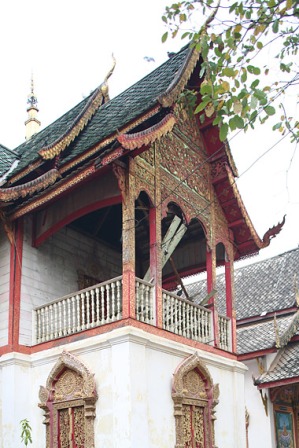One of the lesser-sung buildings in the tradition of religious architecture in Thailand is the ho trai or Buddhist scripture library. The best place to see one on a trip to the ancient town of Lamphun is undoubtedly at Phra That Hariphunchai, which is the premier temple in town. There is much to enjoy at the wat including some extremely rare chedis from the Haripunchai kingdom, but it also worth sparing some attention for its library. This one is very much in the Lanna architectural tradition, bearing a close resemblance to the famous cousin at Wat Phra Singh in Chiang Mai.

It rests on a tall and narrow three-metre high stone base, which is painted barn-red. This height would have not only have protected it from flooding but also the predations of insects. It is also notable for its naga guardians perched at the top of the slender staircase. The upper portion of the library is an elegantly proportioned teak structure with elaborate woodcarving and the Thai roof ornaments known as chafoh. The ones on the ho trai are of the garuda-shaped variety. Even in a temple overflowing with venerable structures, this one is an eye-catching beauty, an excellent example of old Lanna charm.

By way of contrast, it is worth comparing the solid, stone-based ho trai at Wat Phra That Haripunchai with the one at nearby Wat Mahawan Woramahawihan. Dating from the 1940s, it is not of any great antiquity but it is an attractive example of a rustic, wooden scripture library. It is a two-storey structure with timber balustrades, a multi-tiered roof and elaborate wood-carving on its gables. The wooden panels over the windows are elaborately carved dharmacakras and attendant deers, a reference to the episode of the Buddha’s first sermon at Sarnath. Overall, the structure has of a more humble, village-styled feel than its counterpart at Wat Phrathat Haripunchai. It is surrounded by a wooden belltower and a small shrine, which appear to be of a similar vintage. It is a good example of a more vernacular style of ho trai.